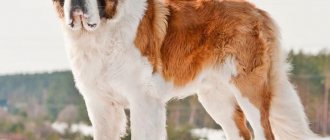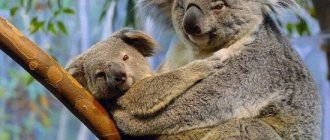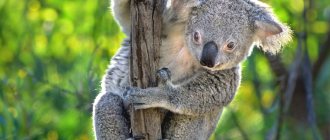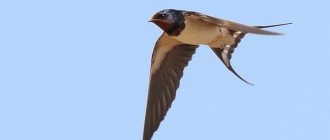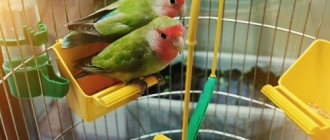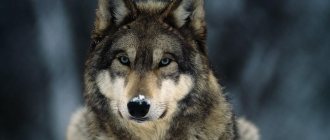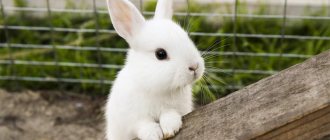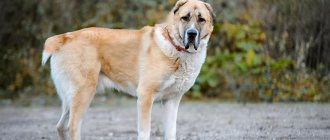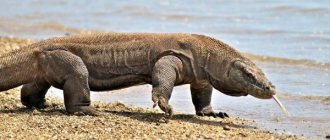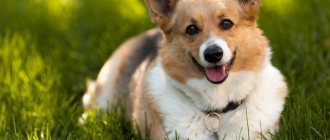Ecology
Australia is famous for its unique wildlife
: living creatures live here that are not found anywhere else in the world.
Some of the most amazing creatures that have survived in Australia are animals of the infraclass marsupials
.
Marsupials first appeared in what is now South America
, however, they were later replaced by animals of other groups.
Today there are very few of them left. The only marsupial creature that managed to survive in North America and survive to this day is the Virginia opossum
.
Marsupials of Australia
Baby marsupials
Marsupials, as their name suggests, are distinguished by the presence of a special pouch
, in which newborn offspring are carried. The cubs are born underdeveloped and must spend some time in the mother's pouch.
The embryos of vertebrates have a general order of development, that is, at some stage the embryos of mammals, fish, reptiles and birds
very similar.
The internal organ systems develop first, then the limbs. In marsupials, the order of growth is somewhat different: they first develop limbs
, which are necessary so that the baby can move into the mother’s pouch, where its development continues.
This premature birth of offspring is unique among mammals.
, as it gives them one more property: an underdeveloped baby is able to breathe through the skin.
For example, a baby Douglas marsupial mouse
is born 12 days after conception.
The baby's lungs are completely undeveloped, so he receives oxygen through his own skin
. After three weeks in his mother's pouch, his lungs have developed enough to breathe normally.
Oviparous
Monotremes, or oviparous animals, are the only mammals that reproduce by laying eggs. Representatives of this order, the platypus and the echidna, live in Australia.
Echidna
This unusual medium-sized animal (body weight up to 6 kg) lives in forests, shrub-steppe landscapes, and sandy plains. Leads a twilight and nocturnal solitary lifestyle. Each individual has its own hunting area. If there is enough food, the echidna is active all year round, but if there is a lack of it, it can fall into torpor even in the summer.
The echidna's diet consists of small insects, mainly ants and termites. The animal collects prey with its long sticky tongue.
Platypus
The platypus lives near rivers, lakes and mountain streams in Eastern Australia, spending most of its time in the water. And its whole appearance speaks of adaptation to a semi-aquatic lifestyle. The body is flattened, covered with short thick fur. The head ends in a “duck beak” about 7 cm long, penetrated by the endings of nerve fibers. The structure of the beak allows the platypus to use it to detect prey. The ear openings open next to the small eyes. Five-fingered limbs with a swimming membrane. There is a spur on the hind legs into which the duct of the poisonous gland opens. The tail is flat and quite powerful. The bag is missing.
The diet is based on larvae of aquatic insects, small fish, crustaceans, mollusks, etc.
Marsupial bear
Strange sounds of koalas
Male koalas produce peculiar sounds reminiscent of grunting
. It was believed that these sounds helped scare away other male competitors from the territory. The researchers used a GPS device to monitor the animals' behavior and their reactions to different sounds.
It turned out that the strange grunting is actually produced by males to attract females.
and not to scare off competitors. Baby koalas can also make certain sounds when separated from their mother that allow her to find them.
Danger from bacteria
The number of koalas in Australia is declining. There are several reasons for this: loss of habitat, dog attacks, death under the wheels of cars. However, the biggest threat to koalas is chlamydia bacteria.
. In some areas of the country, up to 90 percent of koalas are infected with chlamydia and this disease is very dangerous. It can deprive animals of their vision, lead to infertility and even death.
Koalas can be cured with antibiotics, just like humans. There are special hospitals for animals where they are provided with appropriate treatment
, however, it is very difficult to control the spread of the disease. Animals are highly vulnerable to this disease, and scientists cannot understand why.
Today, researchers are busy studying the immune system of koalas and trying to decipher their genome. There are successful attempts to protect animals from the spread of the disease, vaccines are being developed
.
Feathered representatives of the southern continent
Birds in Australia also have a diverse and vibrant community. Among the most famous and exotic are:
- Gould's finch;
- helmeted cassowary;
- emu and others.
Gould's finch
Gould's finch is a small colorful bird, barely reaching 13 cm in size. Its colors include yellow, green, purple, blue, red and black.
Gould's finch is a constantly migratory bird
Helmeted cassowary
The helmeted cassowary is a bird whose size is not inferior to the largest bird - the ostrich. The bird got its name because of the growths on its head that resemble a helmet. The cassowary grows up to 2 meters in height and weighs 60 kg. The bird is considered potentially dangerous to humans because it can attack. This is a very active bird, it can jump to its height, swim and run at a speed of 50 km/h. Since there are just over 1,200 individuals left in the wild, the helmeted cassowary is included in the Red Book.
Red Book bird - Australian helmeted cassowary
Ostrich Emu
The emu is considered one of the unofficial symbols of Australia. Emus are classified as birds, although the ostrich does not fly. It moves with the help of strong legs equipped with three fingers. The speed that the ostrich develops is similar to the permitted speed of cars in cities - up to 48 km/h. Such an impressive animal has small vestigial wings. Wings are used when running to stabilize the position of the body. Emu ostriches live almost throughout the entire continent.
The emu is a bird that walks 30 km every day
Marsupial kangaroo
Kangaroos live not only in Australia
To see a wallaby
a population of 60 of these animals has lived
Loch Lomond since the 1940s .
They are very popular among tourists, but conservationists fear that the animals will eventually destroy all the local vegetation, which the local animals also feed on.
In the UK, wallabies can also be found in the south of England
.
The animals were released in the 1940s when authorities banned private zoos. This population numbered about 50 individuals
until the harsh winter of 1963 reduced it by half.
Gradually the number of wallabies sleeping in the south of England began to fall. In 2009
saw the last representative. A similar population of wallabies lived in Hawaii, but it has most likely disappeared there as well.
Animals are drug addicts
Koalas are often accused of getting drunk on their diet.
, which consists of the leaves of eucalyptus trees, but this is just a myth.
These animals are so lazy that they seem to be “drugged.” The real “drug addicts” among marsupials are Tasmanian kangaroo wallabies .
The island of Tasmania is the world's largest producer of poppy, which is used to make legal opiates.
. Hundreds of thousands of hectares of these plants attract the attention of local jumping creatures - kangaroos.
They chew poppy seeds, after which they remain in a narcotic haze all day. The beast, while high, is unable to move in a straight line, but makes crop circles
.
Raising other people's children
Availability of bag
- a mandatory characteristic of marsupials. It is half womb, half cradle, in which the born baby lives for some time. The mother's pouch is an important means of protection for the offspring.
Scientists were quite surprised when they noticed that the cubs of a completely different mother could hide
. What’s even stranger: the second female was not at all against “borrowing” her child. That is, kangaroos exchange their own children without a second thought and quite voluntarily.
This is the first time this type of behavior has been recorded in the wild, although it sometimes happens in captivity. By the way, if someone else’s baby gets into the bag, it remains there forever
, that is, the female takes care of other people's offspring as if they were her own.
enemies are nearby.
: in a fit of panic, they simply cannot distinguish their own children from strangers, so if you see a baby kangaroo in a female’s pouch, this does not mean at all that it is her own baby.
Lifestyle
Among marsupials there are both terrestrial and arboreal lifestyles, and the water possum has adapted to life in the water. Most are nocturnal animals.
Koala is a marsupial adapted to an arboreal lifestyle.
Diet
Among marsupials there are herbivorous, predatory and omnivorous species. Some people prefer only one type of food. For example, the proboscis-headed cuscus specializes in nectar and pollen. Others, such as four-eyed opossums, are very picky eaters. Their diet includes fruits, earthworms, insects and small vertebrates.
Social life
Four types of social organization of marsupials can be distinguished. In the first case, the structural unit is an individual whose area partially overlaps with several other areas. Males have large ranges that include those of several females, and mating is promiscuous. This is how small opossums and the proboscis possum live.
In the second type, the structural unit is also an individual, but with limited overlap of areas. The male's area overlaps with the areas of 1-2 females, with whom only he can mate. This type of social organization is characteristic of leaf-eating tree species.
The third type is family associations that share a common, often protected, territory among themselves. Groups may consist of a monogamous couple and their offspring or a dominant male, several adult females and young animals. Marsupial flying squirrels and some possums live in groups.
The fourth type are families of large kangaroos. In this social organization, the structural unit is a group of heterosexual individuals. Mating in such groups is promiscuous, and access to females is based on the size and dominance of the males.
Communication
In the communication of marsupials, the main role belongs to hearing and smell. Thus, arboreal species use sound signals to communicate over distances of up to several hundred meters. Some, such as small gliders, may chirp or squeak, while others, such as the koala, may roar.
Scent communication is carried out by passively leaving urine and excrement, and small species actively mark using the secretions of the skin glands.
Since marsupials are mostly active at night, vision is not of great importance for them.
How long do marsupials live?
The lifespan of a kangaroo in the wild is about 25 years. Small marsupials live shorter lives than large species. The shortest age of all is some species of predators, which die at the age of 12 months. The exception is the mountain cuscus, which lives longer than all small mammals: a female in nature can live more than 11 years.
Australian marsupials
Marsupials with lizard-like features
In the Australian state of Queensland
The fossilized remains of strange ancient creatures were discovered: an unknown to science marsupial the size of a ferret, which later received the name Malleodectes.
The teeth of this strange animal were unique; no other mammal has anything like it
.
It had one large, blunt tooth on each side of its upper jaw, which was shaped like a hammer. Teeth can tell a lot about nutrition, but what could this strange creature eat?
Scientists from the Queensland Museum
noticed that the teeth of this creature resemble the teeth of an Australian lizard of the
skink
(pictured).
This lizard uses these hammer teeth to crack the shells of snails
.
The newly discovered creature has nothing in common with the lizard: both creatures developed such features completely independently of each other
. Apparently, the ancient marsupials also really liked to feast on snails.
Marsupial animal
The rarest marsupial
Gilbert's potoroo is considered the world's rarest marsupial.
from the
kangaroo rat
.
For about 120 years
, the animal was considered extinct until
1994
about forty of these rodent-like creatures were discovered in one of the Australian reserves near the city of
Albany, Western Australia
This area was supposed to be settled, but Prince Philip
, husband of Elizabeth II, campaigned to protect these areas and protect rare birds.
For example, the noisy bushbird
, once native here, was also thought to be extinct until
its representative was discovered in 1961
Potoroo Gilbert
is still seriously endangered.
Conservationists have created opportunities to breed these animals in captivity
to increase their numbers and protect them from predators. Some of them are released into the wild.
Researchers hope to learn more about these rarest animals in the world
and find them other suitable places to live where they have a better chance of survival.
Marsupial mammals
Transoceanic relatives of marsupials
As already mentioned, marsupials originated in South America. One of the species arrived in Australia approximately 55 million years ago.
and is the ancestor of all modern Australian marsupials, including
koalas, kangaroos and wombats.
This first marsupial resembled a mouse and was called
dzhartiya.
As it turns out, the early descendants of the Jartiyas could return to South America. Small mountain monkey - bell
is a tree-climbing marsupial that lives today in the mountain forests of Chile and Argentina.
Scientists have suggested that the creature is more closely related to the marsupials of Australia
than to those found in South America. The fossilized remains of dzhartiyas, found in 2008, confirm this assumption.
Koalas
Marsupial bears (koalas) are herbivorous mammals that live exclusively in trees. Some of the most recognizable Australian animals. Cute charming animals, extremely slow, which is caused by the consumption of low-protein food. They deftly climb tree branches and can jump from one eucalyptus tree to another. They descend to the ground just to move to another tree, they know how to swim. Koalas have a characteristic feature - they have a papillary pattern on their fingertips, like a human. Modern koalas have one of the smallest brains in terms of volume among marsupials; the ancestors of koalas had a much larger brain volume.
Australian marsupial
Paper made from marsupial feces
Animals mark their territory in a variety of ways. The most common way is to urinate to leave a scent, but wombats
prefer to leave small
piles of their feces
wherever they see fit to ward off other animals: excrement can often be found on rocks, on logs and even on mushrooms.
The problem is that round shaped feces can easily roll away and get lost.
. To solve this problem, wombats have learned to defecate not in balls, but in... cubes.
They can produce 4-8 of these cubes
during one bowel movement, and leave them approximately at the height of the nose so that competitors can easily notice them. Wombat feces are covered with sticky mucus and have a specific sweet smell.
By the way, wombat feces are used in industry. One Australian company that produces souvenirs turns them into paper.
. At first they made paper from kangaroo excrement, but then switched to raw materials from other marsupials. Animal feces are boiled and then processed into pulp.
Population and species status
By the beginning of the last century, marsupial wolves were on the verge of extinction. In 1928, the Tasmanian Advisory Body, which oversaw the local fauna, recommended the creation of a reserve and the placement of all remaining individuals within it. In 1930, farmer Wilf Batty shot the last marsupial wolf.
Interesting to know! The last marsupial wolf was captured within the Florence Valley in 1933. After this, the animal was sent to Hobart Zoo. Here the marsupial wolf lived only three years and died in 1936. This marsupial predator was filmed and is therefore the only witness to the existence of these mammals on our Planet.
For many years people have tried to find evidence of the existence of marsupial wolves in the wild, but no such evidence has been found. Between 1967 and 1973, some zoologists, together with local farmers, carried out an intensive search, including on the coast of Tasmania. Not only did they investigate many of the reported sightings, but they also deployed automated cameras themselves. In 12972, an entire expedition was organized to find evidence of the existence of marsupial wolves, but this group was unable to find any evidence.
Until 1980, marsupial wolves were listed in the International Red Book as an endangered species. Based on international standards, a species can be considered extinct if for half a century there has been no information about it that could confirm the opposite. During this period of time, it was not possible to obtain any evidence indicating the existence of the marsupial wolf in the natural environment. The status of the species remained unchanged, so in 1982 the International Union for Conservation of Nature declared that marsupial wolves were extinct as a species. In 1986, the Tasmanian government removed the animal from Schedule I of its Trade in Critically Endangered Species of Wildlife. This happened in 2013.
